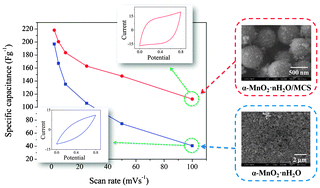Enhancement of the electrocapacitive performance of manganese dioxide by introducing a microporous carbon spheres network†
Abstract
An amorphous MnO2·nH2O/microporous carbon spheres (α-MnO2·nH2O/MCS) composite

* Corresponding authors
a
School of Chemistry and Chemical Engineering, Shanghai Jiao Tong University, Shanghai 200240, People's Republic of China
E-mail:
xbhuang@sjtu.edu.cn
Fax: +86-21-54741297
Tel: +86-21-54743264
b School of Materials Science and Engineering, Shanghai Jiao Tong University, Shanghai 200240, People's Republic of China
c National Key Laboratory of Metallic Matrix Composite Material, Shanghai Jiao Tong University, Shanghai 200240, People's Republic of China
An amorphous MnO2·nH2O/microporous carbon spheres (α-MnO2·nH2O/MCS) composite

 Please wait while we load your content...
Something went wrong. Try again?
Please wait while we load your content...
Something went wrong. Try again?
W. Wei, X. Huang, Y. Tao, K. Chen and X. Tang, Phys. Chem. Chem. Phys., 2012, 14, 5966 DOI: 10.1039/C2CP23235A
To request permission to reproduce material from this article, please go to the Copyright Clearance Center request page.
If you are an author contributing to an RSC publication, you do not need to request permission provided correct acknowledgement is given.
If you are the author of this article, you do not need to request permission to reproduce figures and diagrams provided correct acknowledgement is given. If you want to reproduce the whole article in a third-party publication (excluding your thesis/dissertation for which permission is not required) please go to the Copyright Clearance Center request page.
Read more about how to correctly acknowledge RSC content.
 Fetching data from CrossRef.
Fetching data from CrossRef.
This may take some time to load.
Loading related content
